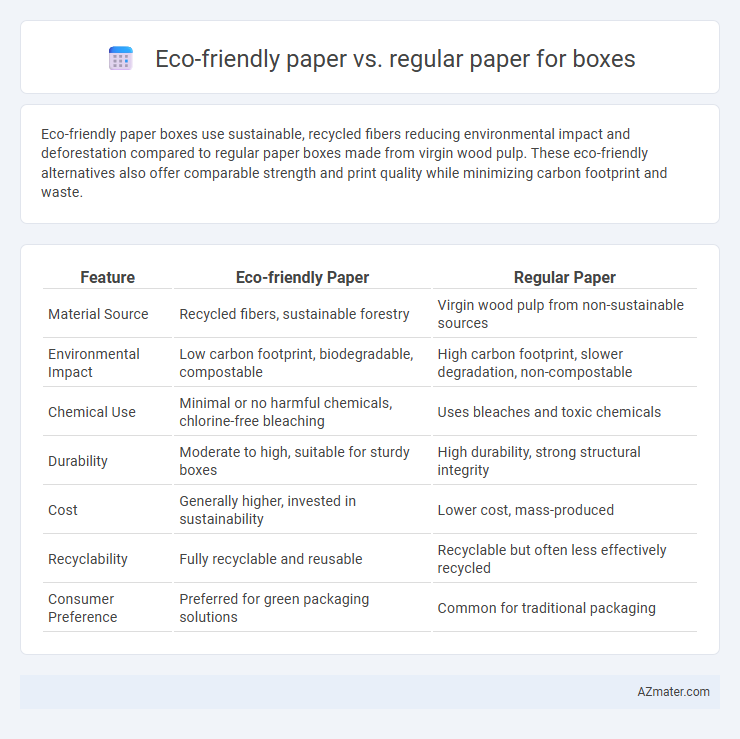Eco-friendly paper boxes use sustainable, recycled fibers reducing environmental impact and deforestation compared to regular paper boxes made from virgin wood pulp. These eco-friendly alternatives also offer comparable strength and print quality while minimizing carbon footprint and waste.
Table of Comparison
| Feature | Eco-friendly Paper | Regular Paper |
|---|---|---|
| Material Source | Recycled fibers, sustainable forestry | Virgin wood pulp from non-sustainable sources |
| Environmental Impact | Low carbon footprint, biodegradable, compostable | High carbon footprint, slower degradation, non-compostable |
| Chemical Use | Minimal or no harmful chemicals, chlorine-free bleaching | Uses bleaches and toxic chemicals |
| Durability | Moderate to high, suitable for sturdy boxes | High durability, strong structural integrity |
| Cost | Generally higher, invested in sustainability | Lower cost, mass-produced |
| Recyclability | Fully recyclable and reusable | Recyclable but often less effectively recycled |
| Consumer Preference | Preferred for green packaging solutions | Common for traditional packaging |
Introduction to Box Packaging Materials
Eco-friendly paper used for box packaging is made from sustainable sources such as recycled fibers and rapidly renewable plants, significantly reducing environmental impact compared to conventional wood-pulp-based regular paper. This sustainable material offers comparable durability and print quality while minimizing carbon footprint and promoting circular economy practices. Brands seeking green packaging solutions prioritize eco-friendly paper to enhance product appeal and demonstrate corporate social responsibility.
What is Eco-Friendly Paper?
Eco-friendly paper is made from sustainable materials such as recycled fibers, agricultural residues, or responsibly harvested wood, minimizing environmental impact compared to regular paper derived from virgin pulp. This type of paper uses less water, energy, and harmful chemicals during production, resulting in reduced greenhouse gas emissions and deforestation. For boxes, eco-friendly paper enhances recyclability and compostability, supporting circular economy practices in packaging solutions.
Overview of Regular Paper for Boxes
Regular paper used for boxes is commonly made from wood pulp and often includes chemical additives to enhance strength and durability. It typically lacks sustainable sourcing certifications and has a higher environmental impact due to deforestation and energy-intensive manufacturing processes. Despite its lower upfront cost, regular paper boxes contribute more to landfill waste and carbon emissions compared to eco-friendly alternatives.
Raw Materials and Sourcing
Eco-friendly paper for boxes is typically made from recycled fibers or sustainably sourced virgin materials certified by organizations like FSC or PEFC, reducing deforestation and environmental impact. Regular paper often relies on non-recycled wood pulp harvested through conventional logging, which may contribute to habitat loss and higher carbon emissions. Sustainable sourcing in eco-friendly options promotes responsible forest management, ensuring biodiversity conservation and minimizing resource depletion.
Environmental Impact Comparison
Eco-friendly paper boxes significantly reduce environmental impact by utilizing recycled materials and sustainable sources, leading to lower deforestation rates and less energy consumption during production compared to regular paper boxes. Regular paper production often relies on virgin wood pulp, contributing to higher carbon emissions, greater water usage, and increased chemical waste. Choosing eco-friendly paper boxes supports waste reduction and promotes a circular economy, minimizing landfill contributions and improving overall sustainability.
Manufacturing Processes and Energy Use
Eco-friendly paper boxes are manufactured using recycled fibers or sustainably sourced materials, significantly reducing deforestation and water consumption compared to regular paper boxes made from virgin pulp. The production of eco-friendly paper typically involves lower energy consumption due to fewer chemical processing steps and the use of renewable energy sources in advanced mills. In contrast, regular paper manufacturing requires high energy input for pulping, bleaching, and refining, resulting in a larger carbon footprint and increased greenhouse gas emissions.
Durability and Performance in Packaging
Eco-friendly paper for boxes offers comparable durability to regular paper while providing enhanced resistance to moisture and tearing due to advanced fiber treatments and recycled content reinforcements. Performance in packaging sees eco-friendly paper maintaining structural integrity during shipping, reducing environmental impact without compromising protective qualities. Regular paper may have slightly higher tensile strength but lacks the sustainability benefits and often involves more chemical processing.
Cost Analysis: Eco-Friendly vs Regular Paper
Eco-friendly paper boxes generally incur higher production costs due to sustainable raw materials and environmentally friendly manufacturing processes, impacting overall pricing. Regular paper boxes benefit from established supply chains and lower material expenses, making them more cost-effective for mass production. However, long-term savings and potential regulatory incentives can offset the initial premium of eco-friendly paper in packaging.
Consumer Perception and Market Trends
Eco-friendly paper boxes are increasingly favored by consumers seeking sustainable packaging options, reflecting a growing market trend toward environmental responsibility. Studies show that 68% of buyers associate eco-friendly packaging with higher product quality and brand trustworthiness. Market analysis reveals a 25% annual growth rate in demand for biodegradable and recycled paper boxes compared to regular paper alternatives.
Future of Sustainable Box Packaging
Eco-friendly paper used in box packaging significantly reduces environmental impact through biodegradability and recycled content, promoting a circular economy in the packaging industry. Innovations in sustainable box packaging focus on enhancing durability and print quality of eco-friendly paper while minimizing carbon footprint during production. Future trends indicate a growing demand for eco-friendly paper boxes driven by consumer preference and stringent environmental regulations.

Infographic: Eco-friendly paper vs Regular paper for Box
 azmater.com
azmater.com